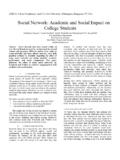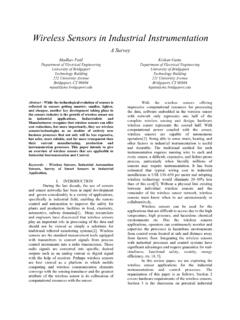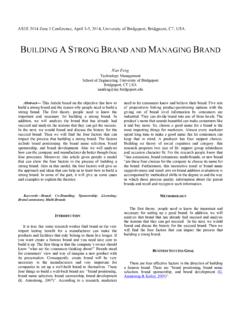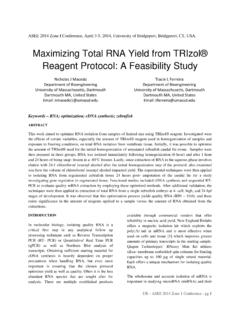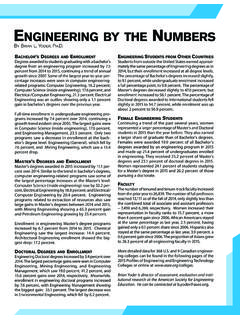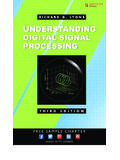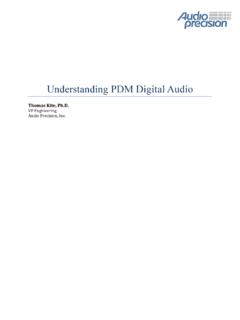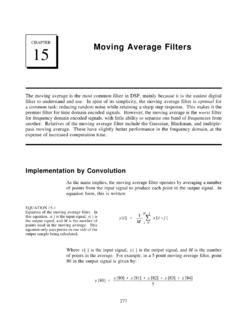Transcription of Siben Dasgupta Associate Professor, Wentworth …
1 Teaching digital signal processing with MATLAB,Simulink and DSP Kits A Practical, Cohesive, and Hands-On Approach Siben Dasgupta Associate Professor, Wentworth institute of Technology Abstract This paper provides an introduction to digital signal processing topics taught in the undergraduate electronics /computer engineering programs at Wentworth institute of Technology. This paper describes how Wentworth institute of Technology provides hands on experience with real signals by using a laboratory based on MATLAB and SIMULINK running on PC s. In addition, an innovative approach is provided in this paper for integrating DSP course in to the graduate program at Heritage Engineering College in Calcutta, India. The author introduced this approach during his sabbatical at Heritage Engineering College by providing the opportunity to conduct hands on experiments with real signals and hardware, using Texas Instruments (TI) C6713 evaluation boards, MATLAB and SIMULINK.
2 DSP is traditionally a highly mathematical subject, and the standard DSP textbooks contain a lot of mathematical exposition. This is necessary for a profound understanding of the subject. The author believes that the principles of DSP can best be learned through interaction in a laboratory setting, where students can appreciate the concepts of DSP through real-time implementation of experiments and projects. Introduction In the past, digital signal processing courses were taught mostly at the graduate level, and it was rare to find them in undergraduate engineering and engineering technology curricula. However, in the past decade, the elements of DSP design have been integrated into many under graduate engineering and engineering technology programs. To obtain specific information about DSP courses taught in undergraduate electronics/computer engineering technology programs in the US, the questionnaire was developed and telephone survey was done to most of the members of the Engineering Technology Division of the American Society for Engineering Education.
3 Survey responses indicate only four year electrical / electronics engineering technology programs offer DSP courses taught at their institution focus on DSP. About half of the Institutions do not have any hardware lab for the course. Similar survey was done by the author last fall during the sabbatical at Heritage institute of Technology at Calcutta. Survey results indicate that majority of the institutions do not have any hardware lab. One aspect is common for both in USA and India is that the DSP courses are usually perceived by the students as too theoretical and mathematically intensive. Many institutions indicated that much work is needed to setup good labs to motivate the students to make DSP more tangible. In this paper the author describes a comprehensive-based DSP laboratory course with the help of MATLAB, SIMULINK, and the Texas Instruments DSP kits with TI 6713 evaluation board. This paper describes how Wentworth institute of Technology provides hands on experience with real signals by using a laboratory based on MATLAB and SIMULINK running on PC s.
4 In addition, an innovative approach is provided in this paper for integrating DSP course in to the graduate program at Heritage Engineering College in Calcutta, India. digital signal processing at Wentworth institute of Technology Course Outline The DSP course at Wentworth institute of Technology is developed with an objective to help the students to learn DSP s and carry out a project in stages, through gradual steps, in subjects related with signal processing which can be found in industry, such as digital filters, echo cancellation, audio equalizers, modems, voice processing algorithms etc. DSP lecture series is organized to move from simple continuous time sinusoidal signals, to discrete time signals and systems, then back to continuous time, and finally, the discrete and continuous are mixed together in filter design. We started the lecture series with a detailed discussion of continuous time sinusoidal signals and their representation by complex exponentials.
5 Second series of lecture consists of introduction of Fourier series. In this section students are introduced to spectrum analysis of mixed sinusoidal signals, AM signals, beat notes, and chirp signals. In the third series of lecture, we introduced the concepts of sampling of sinusoidal signals along with sampling theorem. Up to this point we have focused our attention on signals and their mathematical representations. In the next series of lecture, we begin to emphasis basic filters. We have introduced FIR (finite impulse response) systems or, as we will often refer to them as FIR filters. The key concept of frequency response along with convolution is introduced in the next series of lecture and this concept is applied to FIR filters. We have shown that the frequency response and impulse response are uniquely related. In the next lecture series we introduced Z transforms, which brings polynomials and rational functions in to the analysis of linear time discrete systems.
6 The Z transforms methods introduced in this lecture series is for FIR filters and finite length sequence in general. Next we have introduced new class of LTI systems called IIR filters. The Z transforms of IIR filters along with frequency response are also introduced in this lecture series. At this point, we returned to continuous time signals and systems and discussed the design of different types of analog and digital filters. Also, we have shown how to use the transfer function of the DSP system equation to determine its stability and other filter characteristics. One lecture series was devoted on Discrete Fourier Series, Discrete Fourier Transform, linear convolution from circular convolution, Fast Fourier Transform, effect of windowing on FFT. Last series of lecture covered several practical filter design considerations, such as choosing an IIR or FIR filter and the effects on the system output of the number of ADC and DAC bits use.
7 We spent some time in the applications of digital signal processing such as: Speech processing , Speech analysis, speech coding, noise cancellation etc. MATLAB demonstrations with real life signals were extensively used during the lecture which is unique to Wentworth for undergraduate program. Advanced digital signal processing Graduate level course at Heritage institute of Technology at Calcutta, India. Heritage institute of Technology invited the author for one semester to establish their DSP program for the Master s Level. Like many schools in USA and India, Heritage did not have any hardware labs for DSP. In addition, the experiments they used to use for DSP for undergraduate degree was not up to the US standards because of the availability of MATLAB. During my sabbatical at Heritage, I established hardware and software lab and the course structure for their and program. My own research work over the past decade in applied DSP has inspired me to develop the master s level coursework by identifying practical issues for discussion and presentation to bridge the gap between theoretical concepts and practical implementation, and by suggesting application examples, case studies, and problems.
8 During the first two weeks of , I gave an overview of DSP with the subject matters I taught in the undergraduate level at WIT. Later on I put lot of emphasis in the field of adaptive filtering which is an important part of statistical signal processing . Adaptive filters have found use in many and diverse fields such as communications, control, radar, and sonar, and seismology, etc. I started with random variables and stochastic processes. Then I discussed Wiener filters, Least mean square algorithm, least squares and recursive least squares signal processing . Second series of lecture consists of multirate processing techniques which allow data to be processed at more than one sampling rate and have made possible such novel applications as single bit ADCs and DACs, oversampled digital filtering, which are exploited in a number of modern digital systems, including for example familiar compact disc player. The materials in this series have been extended to include polyphase DSP.
9 More design examples and applications have been integrated into the theory to illustrate both the principles and design issues in practical multirate systems. Next series of lecture consists of spectrum estimation and analysis which are used to describe and study signals in the frequency domain. An application of auto regressive spectrum estimation of evoked response signals in electroencephalogram signals is used to illustrate this method. In the last decade, tremendous progress has been made in DSP hardware, and this has led to the wide availability of low cost digital signal processors. For successful application of DSP using these processors, it is necessary to teach the DSP hardware and software architectures. In particular, I have discussed new DSP architectures such as very long instruction word and super scalar, and new fixed and floating point DSP processors (including Texas Instruments fixed point processors, Motorola fixed point processors, and Analog devices Tiger SHARC).
10 In the next lecture series, I discussed detailed analysis of finite word length effects in modern fixed point DSP systems. In the last lecture series I discussed power spectral estimation, estimation of spectra from finite duration observations of a signal , the periodogram, use of DFT in power spectral estimation, non periodic methods of power spectral estimation, Bartlett, Welch and Blackman, Turkey methods, comparison of performance of non periodic power spectral estimation methods. Laboratory Structure for the Under Graduate Class at Wentworth From the beginning of designing the DSP course, we believed that hands on experience with real signals was crucial. This is provided by a laboratory based on MATLAB running on PCs. In the laboratory assignments, students gain direct reinforcement from hearing and seeing the effects of filtering operations that they have implemented on sound and music signals. They synthesize music from sinusoids, and they see that those same sinusoids are the basis for the data modems that they routinely used in the internet.
